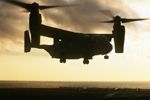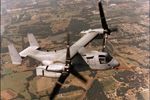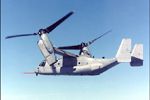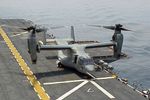
original at www.af.mil |
CV-22 Osprey during sea trials
(U.S. Air Force photo)
It will be awhile before Air Force Special Operations Command gets its first CV-22 Osprey, but that hasn't lowered the command's enthusiasm for the aircraft. The eagerness to get the plane isn't just because the CV-22 will replace up to 89 aircraft currently in AFSOC's inventory. Neither is it just because the CV-22 can take off and land like a helicopter and fly like a turboprop airplane. AFSOC - which has headquarters at Hurlburt Field, Fla. - is confident in the belief that the CV-22 will enable the command to do what it can't do now. That is, conduct long-range, high-speed, vertical lift missions in an aircraft capable of getting troops into and out of an area in one night. Almost futuristic in its design, the CV-22 looks like a helicopter on the ground with two sets of propeller rotors on each wing tip. Once airborne, the rotors tilt forward so the aircraft resembles a dragon fly with turboprops. |

original at www.af.mil |
MV-22 Osprey tiltrotor flies a test mission
(U.S. Air Force Photo)
An MV-22 Osprey was delivered to Bell Helicopter Textron's Arlington, Texas, facility June 7 to be remanufactured into the CV-22, the Air Force version of the tiltrotor aircraft. This aircraft, a representative of future production models, will be used as a flight test vehicle. MV-22 No. 9 is one of four engineering, manufacturing and development (EMD) Marine Corps Ospreys that have been undergoing flight tests at the Naval Air Weapons Center - Aircraft Division (NAWC-AD) at Naval Air Station Patuxent River, Md. The Air Force is acquiring the Ospreys to replace its fleet of MH-53J Pave Low helicopters used to insert and extract special operations forces covertly from hostile areas. The Air Force version of the Osprey will have a Suite of Integrated Radio Frequency Countermeasures (SIRFC), which includes an active jammer. SIRFC can geo-locate threats using its missile warning receivers, as well as incorporate real-time intelligence from a multi-mission advanced tactical terminal (MATT). |

original at www.af.mil |
MV-22 Osprey tiltrotor takes off on a test mission
(U.S. Air Force Photo)
An MV-22 Osprey was delivered to Bell Helicopter Textron's Arlington, Texas, facility June 7 to be remanufactured into the CV-22, the Air Force version of the tiltrotor aircraft. This aircraft, a representative of future production models, will be used as a flight test vehicle. MV-22 No. 9 is one of four engineering, manufacturing and development (EMD) Marine Corps Ospreys that have been undergoing flight tests at the Naval Air Weapons Center - Aircraft Division (NAWC-AD) at Naval Air Station Patuxent River, Md. The Air Force is acquiring the Ospreys to replace its fleet of MH-53J Pave Low helicopters used to insert and extract special operations forces covertly from hostile areas. The Air Force version of the Osprey will have a Suite of Integrated Radio Frequency Countermeasures (SIRFC), which includes an active jammer. SIRFC can geo-locate threats using its missile warning receivers, as well as incorporate real-time intelligence from a multi-mission advanced tactical terminal (MATT). |

original at www.af.mil |
MV-22 Osprey tiltrotor with rotors slightly forward
(U.S. Air Force Photo)
An MV-22 Osprey was delivered to Bell Helicopter Textron's Arlington, Texas, facility June 7 to be remanufactured into the CV-22, the Air Force version of the tiltrotor aircraft. This aircraft, a representative of future production models, will be used as a flight test vehicle. MV-22 No. 9 is one of four engineering, manufacturing and development (EMD) Marine Corps Ospreys that have been undergoing flight tests at the Naval Air Weapons Center - Aircraft Division (NAWC-AD) at Naval Air Station Patuxent River, Md. The Air Force is acquiring the Ospreys to replace its fleet of MH-53J Pave Low helicopters used to insert and extract special operations forces covertly from hostile areas. The Air Force version of the Osprey will have a Suite of Integrated Radio Frequency Countermeasures (SIRFC), which includes an active jammer. SIRFC can geo-locate threats using its missile warning receivers, as well as incorporate real-time intelligence from a multi-mission advanced tactical terminal (MATT). |

original at www.af.mil |
MV-22 Osprey on the USS Saipan
(U.S. Air Force Photo)
An MV-22 Osprey prepares to launch from the USS Saipan in the Atlantic Ocean. Maintainers from Edwards Air Force, Calif., deployed onboard the Navy ship for recent Osprey sea trials. |

original at www.af.mil |
First CV-22 arrives at Edwards
(U.S. Air Force Photo by Dennis Taylor)
The Air Force's newest aircraft, the CV-22 Osprey, landed at Edwards Air Force Base, Calif., Sept. 18 to undergo two years of flight-testing. The Osprey's electronic warfare suite will be tested and then other features will be tested to include a multi-mode radar used for terrain following and terrain avoidance; radar jamming and integrated radio frequency capabilities and special auxiliary fuel tanks. |
^^ TOP ^^
|

